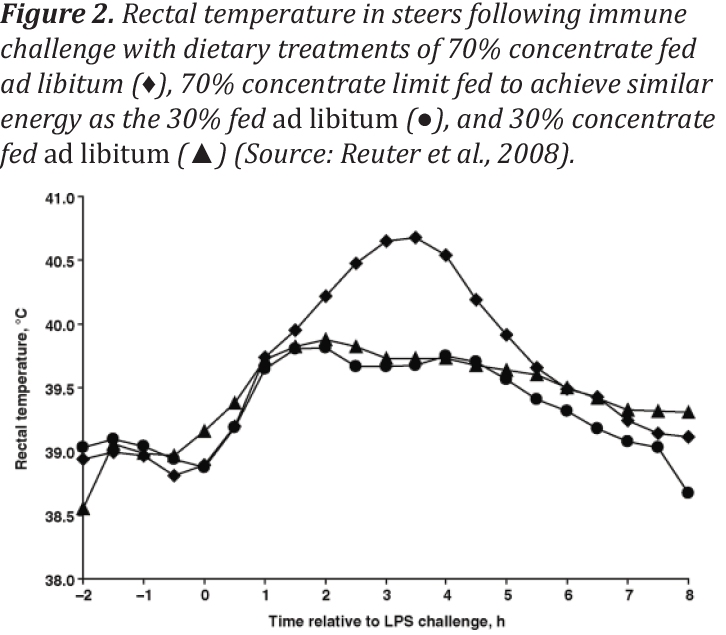
By Dr. Adrian Baker, Ph.D.
Managing new cattle is challenging and the receiving period can have long-term implications on future health and growth during the finishing phase (Wilson et al., 2017). High-risk calves may have been exposed to stressors like commingling at auctions and transportation stress, including extended periods without feed and water (Arthington et al., 2003). A review by Duff and Galyean (2007) illustrates a complex of factors that affect the performance and health of calves with dietary energy being a potential effector of immunity (Figure 1).

Increasing body weight of calves is economically advantageous for producers. Often, energy is fed in diets formulated to above maintenance requirements to increase body weight. Multiple studies were performed by the same author evaluating the effect of increasing concentrate levels in diets to increase net energy for gain (Lofgreen et al., 1975). Average daily gain (ADG) was improved with both 72 and 90% concentrate diets compared to the 55% concentrate, though it appeared the percentage of calves needing treatment for disease was greater as energy concentration in the diet increased (Table 1).

A study was conducted to differentiate the effect of energy and starch in receiving diets (Berry et al., 2004a, 2004b). This experiment was designed with four diets containing two levels of energy (0.38 Mcal/lb vs. 0.48 Mcal/lb) and two levels of starch (corn vs. soy hulls) to evaluate the performance and health of receiving calves.
Researchers investigated the interaction of roughage and energy by feeding diets containing a 70% concentrate fed ad libitum and the same 70% concentrate diet restricted to meet the energy level of the last treatment, which was a 30% concentrate diet fed ad libitum (Reuter et al., 2008). The high concentrate diet fed ad libitum intake led to the greatest ADG, whereas the 30% concentrate diet led to greater dry matter intake than both high concentrate diets. Following a simulated immune challenge, steers consuming the high concentrate diet fed ad libitum exhibited a greater amount of time that body temperature was recorded above basal (Figure 2), and the steers on the high roughage diet exhibited a greater immune response to the challenge.

The previous study summarizes the relationship between energy in diets for newly-received calves and the potential for increased performance with high-energy diets, but the negative consequences on cattle health. The nutritional requirements of newly-received cattle may be challenging to navigate. However, a balance between performance and health can be achieved through formulation and management strategies. Agri-King’s beef nutrition program and area managers can help you optimize management protocols and receiving rations to strike that balance between health and performance. In addition, Beef Jump Start is a product that is formulated to assist with challenges newly received cattle encounter. This product is designed to be fed during the initial 21 days upon arrival when cattle are most susceptible to stress and subsequent illness.
Contact your local Agri-King representative for a customized receiving program to optimize the health and productivity of your calves. AK